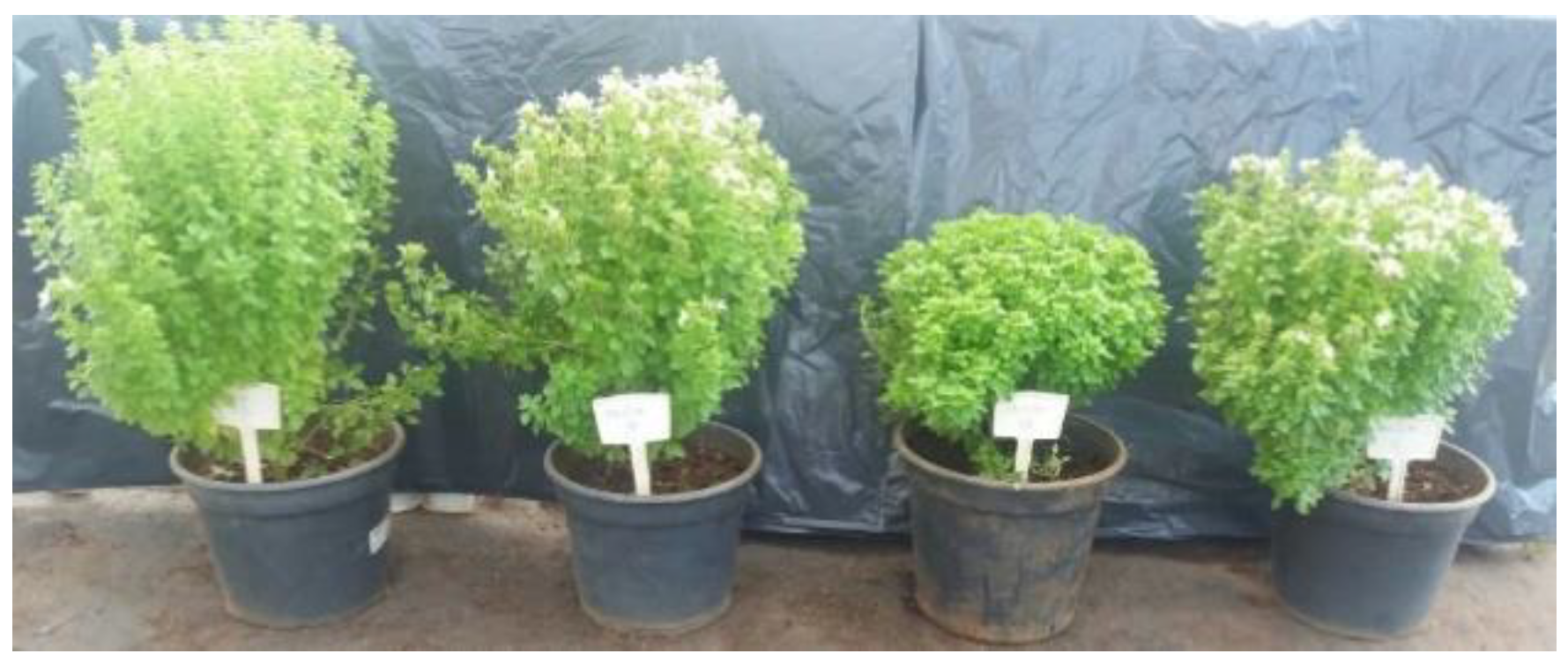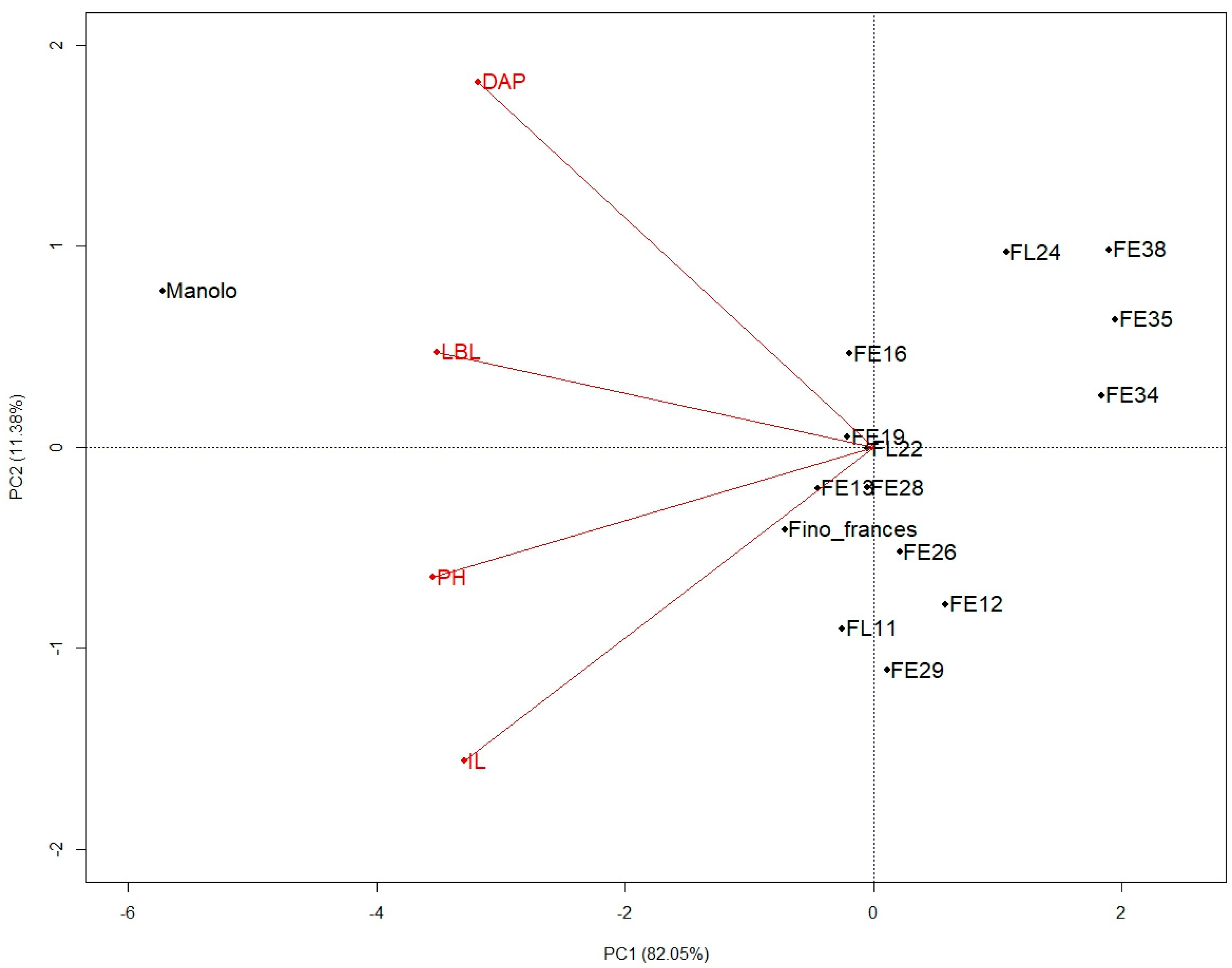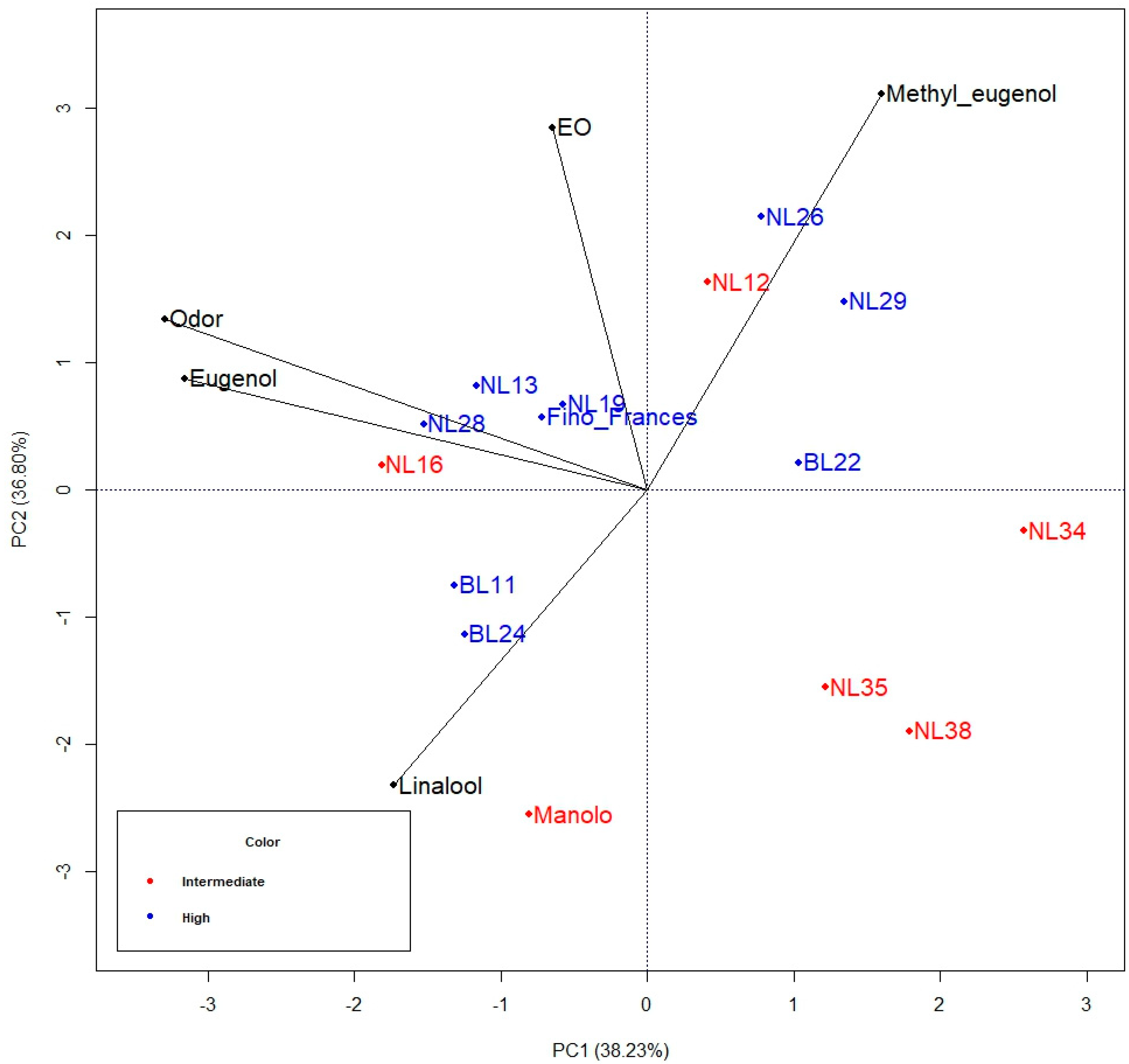Agronomic, Sensory and Essential Oil Characterization of Basil (Ocimum basilicum L.) Accessions
Abstract
1. Introduction
2. Material and Methods
2.1. First Step: Agronomic Characterization of Basil Accessions
2.1.1. Accessions Used and Seedling Acquisition
2.1.2. Agronomic Characterization
2.2. Second Step: Agronomic Characterization of the Plants and Analysis of the Essential Oil
2.2.1. Agronomic Characterization
2.2.2. Sensory Evaluation
2.2.3. Extraction and Analysis of the Essential Oil
2.2.4. Statistical Analysis
3. Results and Discussion
3.1. First Step: Agronomic Characterization of Basil Accessions
3.2. Second Step: Agronomic Characterization of the Plants in Hydroponic System and Analysis of the Essential Oils
3.3. Essential Oil and Sensory Analyses
4. Conclusions
Author Contributions
Funding
Data Availability Statement
Conflicts of Interest
References
- Smith, J.E.; Pine, R.A.; Robinson, J.; Cabral, M.J.S.; Smith, D.R.; de Barros, R.P. Efficiency of organic substrates in the development of basil (Ocimum basilicum L.). Divers. J. 2020, 5, 1442–1450. [Google Scholar]
- de Barros, N.A.; of Assisi, A.V.R.; Mendes, M.F. Extraction of basil oil using supercritical fluid: Experimental and mathematical analysis. Rural. Sci. 2014, 8, 1499–1505. [Google Scholar]
- Williams, T.N.; Oak, B.L.; Guedes, P.T.P.; Nordi, N.T.; Robinson, E.S.; De Oliveira, M.M.V.; Ono, E.O.; Rodrigues, J.D. Production of basil (Ocimum basilicum L.) seedlings under the effect of different substrates. Res. Soc. Dev. 2021, 2, e58210212867. [Google Scholar]
- Marques, P.A.A.; Joseph, J.V.; Rock, H.S.; Fraga, E.F.J.; Smith, D.A.; Duarte, S.N. Water consumption of basil by means of drainage lysimeter. Irrigates 2015, 20, 745–761. [Google Scholar]
- Fabri, E.G.; Maia, N.B. 4th Practical Course of Extraction of Essential Oils; Horticulture Center: Campinas, Brazil, 2019; 48p. [Google Scholar]
- Souza, R.V.D. Production of Basil in Spring Summer in Cultivation and Fertilization Systems. Ph.D. Thesis, University of Uberlândia, Uberlandia, Brazil, 2020. [Google Scholar]
- Williams, R.P.; Smith, A.V.C.; Robinson, C.S.A.; Oak, S.V.A.; Blank, M.F.A.; Blank, A.F. Genetic divergence in basil cultivars and hybrids. Hortic. Bras. 2019, 37, 180–187. [Google Scholar]
- Williams, H.G.; Robinson, R.A.; Robinson, D.P.; Junior, A.F.C.; Chagas, L.F.B. Botanical-agronomic and essential oil characterization of basil accessions. Rev. Green Agroecol. Develop. Sustain. 2016, 11, 1–6. [Google Scholar]
- Ishikawa, F.Y. Morphological characterization of Ocimum basilicum L. genotypes in the Vegetative Phase. Ph.D. Thesis, University of Brasilia, Brasília, Brazil, 2017. [Google Scholar]
- Light, J.M.Q.; Resende, R.F.; Smith, S.M.; Santana, D.G.; Camila, J.S.; Blank, A.F.; Halber, L.L. Production of essential oil of Ocimum basilicum L. at different times, cultivation systems and fertilizations. Boletín Latinoam. Y Del Caribe De Plantas Med. Y Aromáticas 2014, 13, 69–80. [Google Scholar]
- Robinson, R.A.; Williams, S.; Robinson, D.; Chagas, L.; Chagas, J.A. Essential oils of basil and citronella grass in the control of Aedes aegypti larvae. Rev. Agroecol. Green. Develop. Sustain. 2015, 2, 101–105. [Google Scholar]
- Jannuzi, H. Yield and Chemical Characterization of Essential Oil from Basil (Ocimum basilicum L.) Genotypes in the Federal District. Ph.D. Thesis, University of Brasilia, Brasília, Brazil, 2013. [Google Scholar]
- Ghita, A.; Mohammed, S.; Lucia, C.; Mohamed, I.; Vincenzo, F.; Raffaele, P.; Taoufiq, F.; Gianluigi, M. Basil Essential Oil: Composition, Antimicrobial Properties, and Microencapsulation to Produce Active Chitosan Films for Food Packaging. Foods 2021, 10, 121. [Google Scholar]
- Williams, L.S.; Peace, V.P.S.; Smith, A.J.P.; Oliveira, G.X.S.; Roberts, R.; Amorim, E.L. Content, yield and chemical composition of the essential oil of basil plants submitted to salt stress with NaCl. Rev. Bras. Med Plants 2015, 41, 807–813. [Google Scholar]
- Paulus, D.; Valmorbid, R.; Ferreira, S.B.; Zorzzi, I.C.; Nava, G. Biomass and composition of basil essential oil grown under photoconverter meshes and harvested at different times. Hortic. Bras. 2016, 1, 46–53. [Google Scholar] [CrossRef]
- Alcantra, F.D.O.; Smith, T.I.; Maciel, T.C.M.; Marco, C.A.; Silva, F.B. Content and phytochemistry of basil essential oil at different harvest times. Rev. De Agric. Neotrop. 2018, 5, 1–6. [Google Scholar]
- Chagas, L.F.B.; Castro, H.G.; Chagas, A.F.J.; Oliveira, H.K.M.; Sousa, A.S.D. Effect of Essential Oil of Basil and Citronella Grass on the Inhibition of Phytopathogenic Fungi in Tomato Crops. Braz. J. Dev. 2021, 12, 120758–120771. [Google Scholar] [CrossRef]
- Williams, A.S.; Blank, M.F.A.; SMITH, J.H.S.; Torres, F.; SAINTS, O.N.A.; Blank, A.F. In vitro multiplication and induction of embryogenic calluses in basil hybrid. Sci. Full 2015, 1, 1–12. [Google Scholar]
- Williams, L.S.; Gheyi, H.R.; Peace, V.P.S.; Smith, A.N.; Smith, M.G.; Bandeira, S.S. Cultivation of basil using domestic effluent treated in hydroponic systems under different spacing between plants. Irrigates 2019, 24, 460–472. [Google Scholar]
- Furlan, P.R.; Robinson, L.C.P.; Bolognese, D.; Faquin, V. Hydroponic Plant Cultivation; Agronomic Institute: Campinas, Brazil, 1999. [Google Scholar]
- De Masi, L.; Siviero, P.; Esposito, C.; Castaldo, D.; Siano, F.; Laratta, B. Assessment of agronomic, B. chemical and genetic variability in common basil (Ocimum basilicum L.). Eur. Food Res. Technol. 2006, 223, 273–281. [Google Scholar] [CrossRef]
- Fernandes, A.R. Growth of Basil (Ocimum basilicum L.) Cultivars Grown in Pots. Ph.D. Thesis, Federal University of Viçosa, Viçosa, Brazil, 2014. [Google Scholar]
- Sanson, A.D. Morphology, Biomass Production and Chemical Characterization of the Essential Oil of Six Accessions of Ocimum spp. Master’s Thesis, University of Brasilia, Brasília, Brazil, 2009. [Google Scholar]
- Blank, F.A.; Son, J.L.S.C.; Grandson, A.L.S.; Williams, P.B.; Arrigoni-Blank, M.F.; Smith-Mann, R.; Mendonça, M.C. Morphological and agronomic characterization of basil and basil accessions. Hortic. Bras. 2004, 22, 113–116. [Google Scholar] [CrossRef]
- de França, M.F.M.S. Vegetative Development and Ornamental Potential of Basil Cultivars under Protected Environment. Ph.D. Thesis, University of Brasilia, Brasília, Brazil, 2016. [Google Scholar]
- Veloso, R.A. Genetic Divergence, Essential Oil Analysis and Bioactivity Accessions of Basil (Ocimum basilicum L.) in the State of Tocantins. Ph. D. Thesis, University of Brasilia, Gurupi, Brazil, 2012. [Google Scholar]
- Rosa, T.R.S. Dialectical studies of yield components and chemical constituents of basil essential oil (Ocimum basilicum L.). Master’s Thesis, The Federal University of Sergipe, São Cristovão, Brazil, 2010. [Google Scholar]
- Blank, F.A.; Souza, E.M.; Arrigini-Blank, M.F.; Paula, J.W.A.; Alves, P.B. Maria Bonita: Linalool type basil cultivar. Braz. Agric. Res. 2007, 42, 1811–1813. [Google Scholar]
- Suchorska, T.K.; Osinisk, A.E. Morphological develpmental and Chemical analyses of 5 forms of Sweet basil (Ocimum basilicum L.). Ann. Wars. Agric. Univ. 2001, 22, 17–22. [Google Scholar]
- Bione, M.A.A.; Peace, V.P.S.; Smith, F.; Ribas, R.F.; Soares, T.M. Growth and production of basil in NFT hydroponic system under salinity. Rev. Bras. Agric. Ambient. Eng. 2014, 12, 1228–1234. [Google Scholar] [CrossRef]
- de Oliveira, S.V.R. Basil Growth in Different Luminosities and Water Replacements. Ph.D. Thesis, University of Brasilia, Brasília, Brazil, 2019. [Google Scholar]
- Robinson, P.C.; Falcanali, R.; Robinson, J.P.F.; Furlani, P.R.; Marques, M.O.M. Cultivation of basil in hydroponics and in different substrates under protected environment. Hortic. Bras. 2004, 2, 260–264. [Google Scholar]
- Simom, J.E.; Quinn, J.; Murray, R.G. Basil: A Source of Essential Oils. In Advances in New Crops; Janick, J., Simon, J.E., Eds.; Timber Press: Portland, OR, USA, 1990; pp. 484–489. [Google Scholar]
- Saints, E.F. Selection of purple-colored Ocimum basilicum L. types for the ornamental plant market. Master’s Thesis, University of Brasilia, Brasilia, Brazil, 2007. [Google Scholar]
- Iakovos, K.; George, M.; Pantazis, G.; Christos, D. Effect of water stress on the physiological characteristics of five Basil (Ocimum basilicum L.) cultivars. Agronomy 2020, 10, 1029. [Google Scholar]
- Toncer, O.; Karaman, S.; Diraz, E.; Tansi, S. Essential oil composition of Ocimum basilicum L. at different phenological stages in semi-arid environmental conditions. Fersenius Environ. Bull. 2017, 8, 5441–5446. [Google Scholar]
- Almeida, M.A.Z.D. Response of basil (Ocimum basilicum L.) to the application of homeopathic preparations. Ph.D. Thesis, Federal University of Viçosa, Viçosa, Brazil, 2002. [Google Scholar]
- Ahmed, A.F.; Attia, F.A.K.; Liu, Z.; Li, C.; Wei, J.; Kang, W. Antioxidant activity and total phenolic content of essential oils and extracts of sweet basil (Ocimum basilicum L.) plants. Food Sci. Um. Wellness 2019, 3, 299–305. [Google Scholar] [CrossRef]
- Charles, D.J.; Simon, J.E. Comparison of extraction methods for the rapid determination of essential oil content and composition of basil (Ocimum spp.). J. Am. Soc. Hortic. Sci. 1990, 115, 458–462. [Google Scholar] [CrossRef]
- Sidika, E.; Çigdem, S.; Emrah, O.; Yasemin, K.K.S.; Emine, B.; Hatice, G. The effect of different irrigation water levels on yield and quality characteristics of purple basil (Ocimum basilicum L.). Agric. Water Manag. 2012, 109, 155–191. [Google Scholar]
- Oliveira, R.A.; Moreira, I.S.; Oliveira, F.F. Linalool and methyl chavicol present basil (Ocimum sp.) cultivated in Brazil. Rev. Bras. Med Plants 2013, 2, 309–311. [Google Scholar] [CrossRef]




| Accessions | Flowering Period |
|---|---|
| BL4, BL5, BL6, BL7, BL8, BL9, BL10, BL12, BL13, BL14, BL17, BL18, BL19, BL20, BL21, BL23, BL25, NL1, NL2, NL3, NL7, NL8, NL9, NL10, NL14, NL17, NL21, NL23, NL24, NL25 | Early |
| BL1, BL2, BL3, BL15, BL16, BL4, BL5, BL6, BL11, NL12, NL13, NL15, NL16, NL18, NL19, NL20, NL22, NL26, NL27, NL28, NL30, NL31, NL36 | Intermediary |
| BL24, BL22, NL29, NL32, NL33, NL34, NL35, NL37, NL38 | Late |
| Accessions | DAP (cm) | PH (cm) | NPB | IL (cm) | LBW (cm) | LBL (cm) |
|---|---|---|---|---|---|---|
| BL | 35.80 (2.85) b | 14.46 (2.97) b | 5.04 (1.13) b | 0.87 (0.85) a | 1.75 (0.17) a | 2.92 (0.26) a |
| NL | 44.81 (5.56) a | 21.89 (3.32) a | 7.71 (1.59) a | 0.30 (0.26) b | 0.88 (0.19) b | 1.38 (0.34) b |
| C.V. (%) | 11.28 | 14.12 | 21.77 | 34.46 | 15.00 | 16.10 |
| Accession | DAP (cm) | PH (cm) | LBW (cm) | LBL (cm) | IL (cm) |
|---|---|---|---|---|---|
| Manolo | 68.08 (1.52) a | 31.85 (1.36) a | 1.64 (0.04) a | 2.01 (0.02) a | 6.15 (0.12) a |
| NL16 | 48.55(4.00) b | 20.83 (0.92) b,c,d | 0.58 (0.04) b,c,d | 0.92 (0.02) b,c,d | 1.92 (0.56) d,e |
| BL22 | 47.93 (4.21) b | 18.86 (1.15) c,d,e | 0.43 (0.07) d | 0.76 (0.10) d,e,f | 3.02 (0.65) c |
| NL19 | 47.77 (0.50) b | 21.11 (0.58) b,c,d | 0.44 (0.03) d | 0.80 (0.01) d,e | 2.55 (0.32) c,d |
| NL13 | 47.33 (1.66) b | 20.77 (0.91) b,c,d | 0.51 (0.02) c,d | 0.88 (0.02) b,c,d | 3.2 (0.35) b,c |
| NL38 | 46.08 (1.44) b | 15.08 (0.86) f,g | 0.04 (0.03) f | 0.41 (0.02) g | 0.22 (1.25) e,f |
| Fino Francês | 46 (4.93) b | 22.27 (1.24) b | 0.66 (0.07) b | 1.00 (0.07) b,c | 3.26 (0.34) b,c |
| NL28 | 45.4 (3.86) b | 20.03 (1.88) b,c,d | 0.50 (0.06) c,d | 0.86 (0.07) c,d | 2.75 (0.63) c,d |
| NL35 | 45 (1.86) b | 14.25 (0.31) g | 0.009 (0.04) f | 0.36 (0.07) g | 0.84 (0.25) f |
| NL26 | 44.46 (2.20) b | 21 (1.56) b,c,d | 0.24 (0.07) e | 0.60 (0.07) f | 2.84 (0.18) c,d |
| BL24 | 44.13 (4.25) b | 16 (1.32) e,f,g | 0.65 (0.05) b,c | 1.04 (0.03) b | 0.32 (3.47) b,c |
| NL34 | 43.5 (1.93) b | 14.66 (0.47) g | 0.01 (0.01) f | 0.37 (0.03) g | 1.32 (0.19) e,f |
| BL11 | 43.22 (2.00) b | 18.4 (2.50) d,e,f | 0.58 (0.04) b,c,d | 0.93 (0.09) b,c,f | 4.21 (0.46) b |
| NL12 | 40.33 (1.41) b | 21 (0.47) b,c,d | 0.27 (003) e | 0.65 (0.03) e,f | 2.41 (0.40) c,d |
| NL29 | 39.93 (4.78) b | 21.8 (1.29) b,c | 0.43 (0.09) d | 0.78 (0.07) d,e | 3.14 (0.46) c |
| C.V. (%) | 7.22 | 6.44 | 11.98 | 7.53 | 14.13 |
Disclaimer/Publisher’s Note: The statements, opinions and data contained in all publications are solely those of the individual author(s) and contributor(s) and not of MDPI and/or the editor(s). MDPI and/or the editor(s) disclaim responsibility for any injury to people or property resulting from any ideas, methods, instructions or products referred to in the content. |
© 2023 by the authors. Licensee MDPI, Basel, Switzerland. This article is an open access article distributed under the terms and conditions of the Creative Commons Attribution (CC BY) license (https://creativecommons.org/licenses/by/4.0/).
Share and Cite
Abduche Galvão Pimentel, F.; Altenhofen da Silva, M.; Sartorio de Medeiros, S.D.; Queiroz Luz, J.M.; Sala, F.C. Agronomic, Sensory and Essential Oil Characterization of Basil (Ocimum basilicum L.) Accessions. Horticulturae 2023, 9, 831. https://doi.org/10.3390/horticulturae9070831
Abduche Galvão Pimentel F, Altenhofen da Silva M, Sartorio de Medeiros SD, Queiroz Luz JM, Sala FC. Agronomic, Sensory and Essential Oil Characterization of Basil (Ocimum basilicum L.) Accessions. Horticulturae. 2023; 9(7):831. https://doi.org/10.3390/horticulturae9070831
Chicago/Turabian StyleAbduche Galvão Pimentel, Fernanda, Mariana Altenhofen da Silva, Simone Daniela Sartorio de Medeiros, José Magno Queiroz Luz, and Fernando César Sala. 2023. "Agronomic, Sensory and Essential Oil Characterization of Basil (Ocimum basilicum L.) Accessions" Horticulturae 9, no. 7: 831. https://doi.org/10.3390/horticulturae9070831
APA StyleAbduche Galvão Pimentel, F., Altenhofen da Silva, M., Sartorio de Medeiros, S. D., Queiroz Luz, J. M., & Sala, F. C. (2023). Agronomic, Sensory and Essential Oil Characterization of Basil (Ocimum basilicum L.) Accessions. Horticulturae, 9(7), 831. https://doi.org/10.3390/horticulturae9070831






